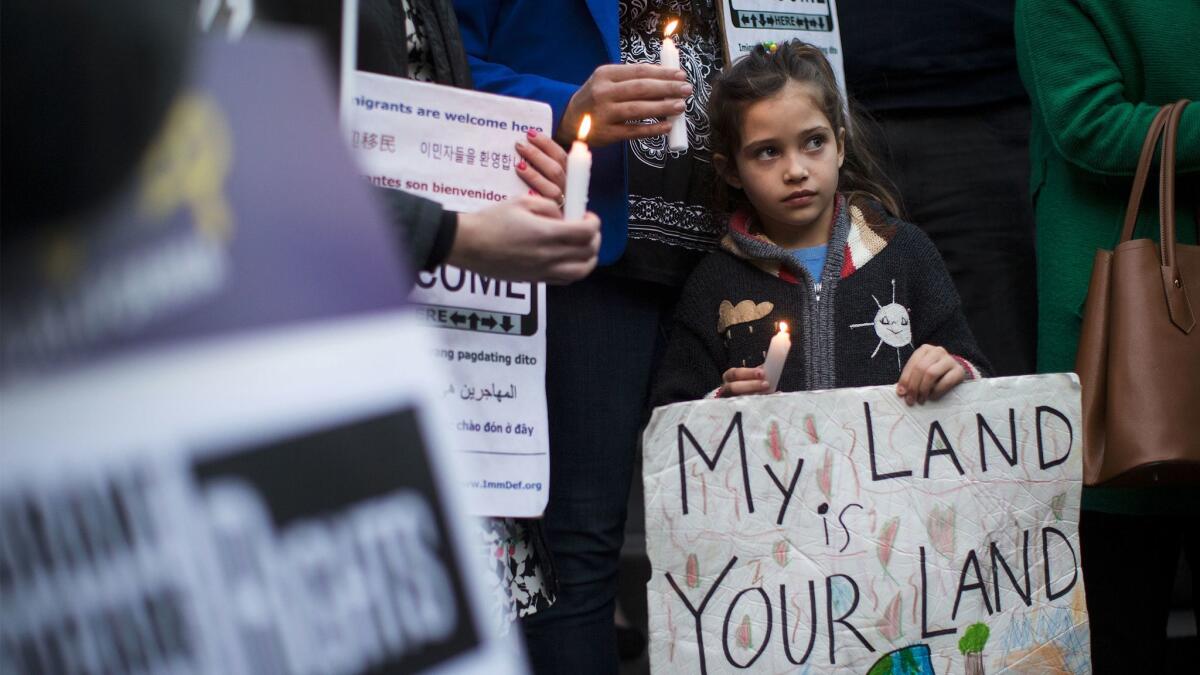California ‘sanctuary cities’ vow to stand firm despite Trump threats of funding cutoff

President Trump’s vow to crack down on “sanctuary cities” that protect immigrants in the U.S. illegally has met with resolve, at least so far, in some California communities.
Details about Trump’s crackdown remain unclear. Trump on Wednesday signed two executive orders designed to begin building a border wall with Mexico, add lockups for detaining immigrants who cross the border illegally, enhance enforcement powers for border agents and strip federal funding to cities that refuse to cooperate with immigration enforcement.
According to a draft document reviewed by The Times, under the new order, the federal government would threaten to withhold funds from cities that limit cooperation with immigration officials.
More than 400 jurisdictions across the country have some sort of sanctuary policy, including Los Angeles, San Francisco and about 40 others in California.
Several smaller towns in Los Angeles County have declared themselves sanctuary cities, and now leaders of those municipalities are wondering how Trump’s orders will affect them.
More than a year ago, Cudahy, a small working-class town southeast of downtown Los Angeles, declared itself a sanctuary city to encourage immigrants without legal status to cooperate with police.
“It was a symbolic gesture to say: You’re here already. You’re free to live your lives, and you can call police,” said City Councilman Cristian Markovich.
Markovich said the policy has no legal teeth because it doesn’t supersede federal law. He said there might be some cooperation with federal authorities, such as police turning over immigrants in the country illegally who commit serious violent crimes.
Markovich said he would oppose any Trump plans to withhold federal funds from sanctuary cities.
“We pay our fair share, and that funding should go to the city regardless of whether the city is a sanctuary city or not,” Markovich said.
He said one way the city could be affected would be the withholding of funds from the Community Development Block Grant program, which is used for parks and public housing.
“I’m going to stick to my guns and say this is a good piece of policy for our city,” Markovich said.
In 2006, the 1-square-mile town of Maywood declared itself a sanctuary city.
“It became second nature,” Mayor Pro Tem Eduardo De La Riva said. “It wasn’t a topic of discussion because California became so progressive over the years, it was sort of the norm.
“But ever since Trump entered the national stage and because of his rhetoric, more cities became sanctuary cities and it once again came to the spotlight, and now we’re having to ask, ‘What does it mean to be a sanctuary city?’ ” he said.
De La Riva, who was not on the City Council when Maywood declared itself a sanctuary city, said the city doesn’t plan to abandon the policy.
California is going to fight Trump all the way and that’s great to have the support from state leadership.
— Maywood Mayor Pro Tem Eduardo De La Riva
“We’re going to wait and see what the executive order states, and then we’re going to have a discussion on what that means for Maywood moving forward,” he said. “California is going to fight Trump all the way, and that’s great to have the support from state leadership. I think we’re sending a clear message when you have several of the largest cities also saying we’re going to take a stance.”
Sanctuary policies have become good politics in cities with large Latino populations. But the protections cities afford vary widely.
There is no neat definition of “sanctuary city,” but in general, cities that adopt the designation seek to offer political support or practical protections to people who are in the country illegally.
For some cities, the sanctuary movement consists simply of encouraging people without legal status to get more involved in government. For instance, Huntington Park has never declared itself a sanctuary city but appointed two people without legal status to a city commission, a move that generated national attention.
Other places, such as San Francisco, adopt far-reaching policies, such as taking steps to cut ties with federal immigration officials and refusing to fully cooperate with them. San Francisco declared itself a sanctuary city in 1989, and city officials strengthened the stance in 2013 with its “Due Process for All” ordinance. The law declared that local authorities could not keep immigrants in custody to be handed over to federal immigration officials if they had no violent felonies on their records and did not currently face charges.
Jessica Vaughan, director of policy studies at the Center for Immigration Studies, a Washington, D.C., think tank that advocates for restrictions on immigration, said cutting off funding to sanctuary cities was a long time coming.
“Money talks,” she said. “But there probably will be some die-hards who will continue to play chicken on this, and they may face other consequences, such as litigation.”
She said it would behoove Trump to expand the types of funding that could be cut off, possibly to include Department of Homeland Security funding.
Inside Express Coin Laundry in Maywood, clothes whirled inside washers and dryers, while President Trump spun in the minds of some customers at the laundromat.
Among them was Hector Cruz, 25, a Mexican national whose newborn son slept in an infant car seat.
“I’m afraid of immigration raids,” Cruz said, peeking over at his son. “I’m worried of being separated from family.”
ALSO
Read a draft copy of President Trump’s executive order on immigration and refugees
Trump’s crackdown on illegal immigration leaves a lot unanswered for sanctuary cities like L.A.
UPDATES:
2:51 p.m.: This article was updated with more reaction from Maywood.
12:15 p.m.: This article was updated with comments from the Center for Immigration Studies.
This article was originally published at 12:05 p.m.
More to Read
Sign up for Essential California
The most important California stories and recommendations in your inbox every morning.
You may occasionally receive promotional content from the Los Angeles Times.











